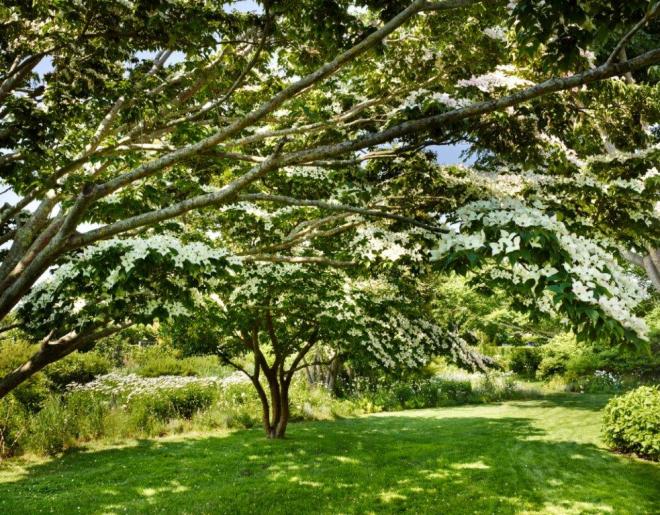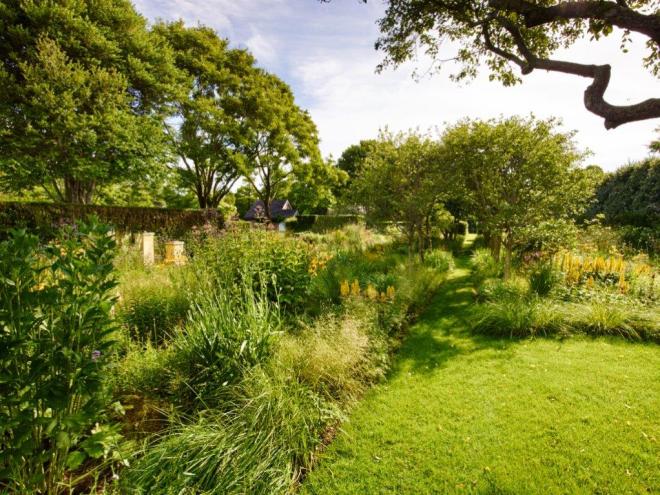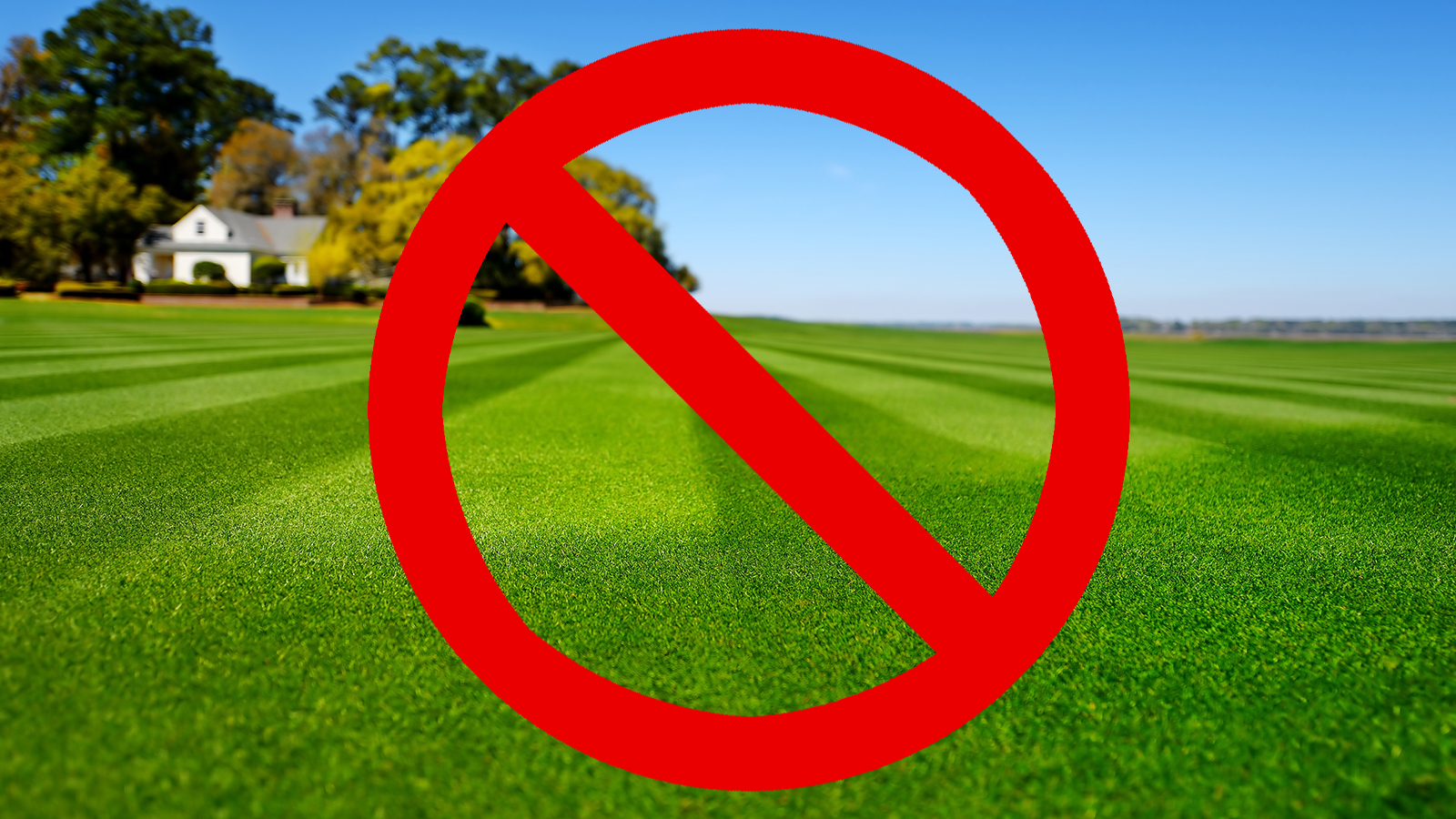The lawn, as we know it, is an anachronism: It’s a living fossil from the 1950s, the era of Levittown, glorified suburban sprawl, and better living through chemistry. And our lawns require a lot of chemistry. Landscapers often apply chemicals to lawns at more than double the concentrations used in industrial agriculture.
Edwina von Gal, a landscape architect, has a vision of a new lawn to match the changing times. It’s a lawn with a diversity of plants, taller grasses, and a gentler, undulating appearance. The shift from the traditional buzzcut carpet of grass is a change in fashion that von Gal compares to burning the bra.
“Ending that kind of strictly imposed landscape maintenance on a lawn is like taking off the corset,” she said. “You are giving your grass a chance to move and live and breathe.”

Alan Pollack-Morris
The organization she started, The Perfect Earth Project, is working to make this new lawn the next must-have fashion item for the American mass market. And she might succeed, thanks, in part, to her location. Von Gal is based in the Hamptons and her roster of clients include the fashion designer Calvin Klein, media kingpin Martha Stewart, and the well-known art dealer Larry Gagosian. Another designer, Isaac Mizrahi, will host an upcoming benefit for the Project at the artist Cindy Sherman’s house this fall. When wealthy celebrities adopt a new style, it’s much more likely to catch on with the general public. You may have dug up your lawn long ago for moral reasons, but the bulk of Americans aren’t going to change unless the rich and famous — who define the aspirational “good life” — change their landscaping first.
 I love the idea of removing pesticides and fertilizer from our national lawn. Still, I worry that von Gal’s campaign could have further demonize important agricultural chemicals. It’s an easy shorthand to think “synthetic chemicals are bad,” but I’ve talked to scientists working on 100-year-plus soil sustainability studies who say that popular notion is absolutely untrue: used properly, synthetic chemicals can be better for the environment than the alternatives. And the Perfect Earth Project’s goal of “toxin-free landscaping” sounds great, but a toxin is a poison made by nature, and of course there’s a lot of those in grass.
I love the idea of removing pesticides and fertilizer from our national lawn. Still, I worry that von Gal’s campaign could have further demonize important agricultural chemicals. It’s an easy shorthand to think “synthetic chemicals are bad,” but I’ve talked to scientists working on 100-year-plus soil sustainability studies who say that popular notion is absolutely untrue: used properly, synthetic chemicals can be better for the environment than the alternatives. And the Perfect Earth Project’s goal of “toxin-free landscaping” sounds great, but a toxin is a poison made by nature, and of course there’s a lot of those in grass.
In a recent interview, I talked to von Gal about the magic of clover, water-logged lawns, and the risk of relying on simplistic chemophobia to achieve noble ends.
This interview has been condensed and edited for clarity.
Q. What’s wrong with the lawn as it is?
A. When you use chemicals — synthetics — you destroy the life of the soil, and it kills a lot of beneficial organisms. Once you’ve killed those organisms you get more parasites and invaders, and then you have to use more chemicals. So what you need to do, in what we call the “perfect maintenance program,” is bring yourself back to a healthy soil.
Q. I have to tell you, I’m turned off by some of the language. There’s this broad-brush idea that all synthetic chemicals are bad. Why lean so hard on the nature-good, chemistry-bad trope?
A. It is true that it is a simplified message. What we’re suggesting is, if you have the choice, why not do without [synthetic chemicals]. If you wish to be extraordinarily well informed and want to make choices in every instance, that’s fine. But we are coming from the assumption that for most people it’s going to be a good deal easier to say to their landscape contractor, “Just don’t use chemicals.”
There is evidence for a lot of the chemicals used in landscaping that they can be harmful, and if you spray indiscriminately you will be killing beneficial insects.

Alan Pollack-Morris
Q. What does your version of a lawn look like?
A. It looks a little more like an area rug than wall to wall, first of all. It’s cut higher. If you are doing a traditional cut of two and a half inches, we ask that you raise the mower to three and a half inches. It’s just like hair, the longer you leave it the more relaxed it looks, so you don’t get that military precision. We ask that you leave the clippings in place. They are a natural fertilizer, and if your lawn is healthy they disappear very quickly. The other thing we ask is that you allow clover. It fixes nitrogen [so there’s no need to add fertilizers] and it makes a great companion to grass. Its texture can be lovely.
It’s really just like fashion, so this is sort of like women burning their bras. Ending that kind of strictly imposed landscape maintenance on a lawn is like taking off the corset, you are giving your grass a chance to move and live and breathe.
Q. If you are allowing the grass to be taller does that have other positive effects?
A. Certainly. The longer leaf blade provides more photosynthesis, and stronger root systems. The grass is healthier and can better muscle out the dandelions or crabgrass. The taller grass also shades out the weeds, and keeps more water moisture in the ground. Watering is the other key element in a healthy landscape; most people water wrong.

Alan Pollack-Morris
Q. How should we water?
A. Water seldom, water deep. Many people water three to five or up to seven times a week. That’s the worst, your grass never dries out, so you are inviting fungus diseases. Also your roots all stay on the surface, so when you do stop watering the grass dries out quickly.
We suggest that you do not turn your irrigation system on until your lawn is begging for it — until the grass has had a chance to work for it, and send down roots.
[Von Gal recommends a watering system based on soil moisture, rather than a regular schedule.]
Q. It’s interesting that this is happening in East Hampton, the swanky part of Long Island, where there are all sorts of fabulous people trying it. So do you think people in the rest of the country will see that these celebrities are doing this and want to try it themselves?
A. We are counting on it! We are also riding on the coattails of the food movement. We don’t have to tell people anymore — in spite of it being a broad brush — to be suspicious of chemicals. We want to just build on that and say, “You have an organic vegetable garden, but you are walking across your chemical-laden lawn to get there. Do you want to rethink that?”
The high-profile clients are always the early adopters. They are the ones who had the first personal fitness programs. They can afford organic. They are the ones who really started the whole spa thing. They are always that one step ahead.



